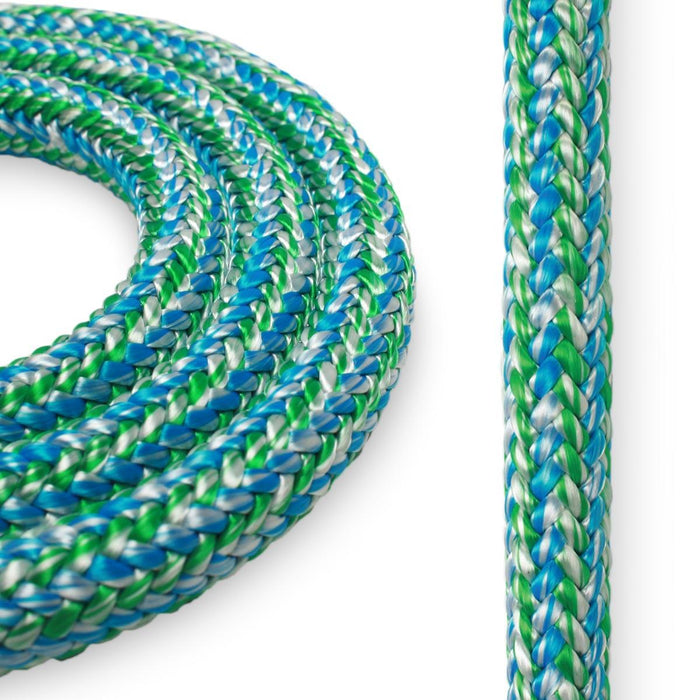
Vortex Rope Cool - Green/Blue
Weight: 0.07 lb

1/2 inch size, the big brother to Velocity.
Vortex rope is a 1/2 diameter rope that builds that is very soft and supple. This rope is easy to tie knots in and easy to splice.
For anyone who wishes that Velocity rope was a little larger, then this rope is for you.
What is the difference between Vortex and Velocity?
Years ago Samson rope came out with a great 24 strand climbing called Velocity. It came in two types, one was called Velocity Hot and the other was called Velocity Cool. They are both the same rope, the only difference is that the "hot" color is a red and orange color, and the "cool" is a blue and green color, otherwise they are the exact same rope. The rope became known for a few things:
Velocity has lots of die hard fans that really love it, Frank Chipps set a world record foot lock time with this rope, so it got a lot of good press from that. Even though it is technically a 7/16 rope, it feels smaller than that, so a lot of guys like the lighter weight, slim down feel of this rope. Sort of a more minimalist thing.
Anyway, this rope comes from the factory with a waxy coating. I say waxy, but it isn't like candle wax, just a "grippyness" that is pretty cool. Again, some guys like that, some don't. Velocity is also a tough 24 strand rope to splice, even when it is new. It does make a great splice, it just takes a bit longer to do, but the results are pretty nice.
Personally, I have a 150' section of this that I use and it isn't bad. For me, it makes a great summer time rope, a nice hot day with a lot of fast movement through the tree and bailout hitch cord works great. In the winter I prefer a little larger rope like a 16 strand rope since I'm wearing gloves and moving slower anyway.
| Strand Count: | 24 Strands |
| Color: | Green, Blue & White |
| Diameter: | 12.7mm (1/2") |
| Weight: | 7.6lbs per 100ft. |
| Tensile Strength: | 8,800lbs (4,000kg) |
| Fiber: | Nylon over Polyester |
Elastic Elongation figures:
| 10% of Breaking strength: | 3% Stretch |
| 20% of Breaking strength: | 5% Stretch |
| 30% of Breaking strength: | 6% Stretch |
Wherever possible, use splices constructed to safe specifications. A proper splice on a rope can maintain 80% to 100% of the new rope average break strength. Trained personnel should construct all splices. If knots are used on a rope, be aware that they can reduce the rope's strength by up to 50%. If knots are required, be sure to select the proper knot for the job.
All rope has a rating referred to as a "tensile strength" or "average break strength." This number is the amount of weight that the rope should be able to hold in ideal conditions, specifically, a new rope, with no knots or splices, at room temperature. These break strength numbers are based on actual destructive break testing by the manufacturer or a certified third-party testing facility. Ropes are tested over many cycles and the average break strength is determined and specified for the product. We test our ropes personally, and all our splicers have their work tested on an ongoing basis using a certified test bed facility. This is to ensure that their splicing work is perfect, and that their splicing technique and skills are 100% within acceptable splicing guidelines set by the rope industry. Even the best splices and best rope can break if overloaded or used improperly. Make sure you thoroughly understand what you are doing with a rope. Get the right rope for the right job. If you have questions or are even remotely unsure or have doubts. STOP and get the information you need to BE SURE you are doing things safely.
Rope wear, knots, extreme hot or cold temperatures, chemicals, the manner in which the load is applied and other factors will result in a break strength lower than the stated average break strength.
A rope with a stated or advertised break strength, in pounds will not necessarily safely hold something that weighs that amount! Refer to the SAFE WORKING LOAD of a specific rope for more information.
IF IN DOUBT, ASK A PROFESSIONAL. We get calls all the time from people who have questions about what is the best rope to use for any given application. Don't be afraid to ask. Ultimately YOU are responsible for your safety using ANY rope, so don't chance it.
In a broad generalization, most working loads vary from 1/10 to 1/4 of the average break strength of the rope. Applications for rope used in life support or personal fall protection environments must use the 1/10 ratio.